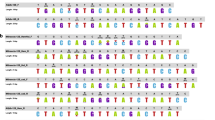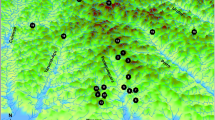Abstract
S1 satellite DNA from Palearctic brown frogs has a species-specific structure in all European species. We characterized S1 satellite DNA from the Anatolian brown frogs Rana macrocnemis, R. camerani, and R. holtzi in order to define their taxonomic rank and the structure of this satellite in this frog lineage. Southern blots of genomic DNA digested with KpnI, EcoRV, NdeI, NheI, or StuI produced the same pattern of satellite DNA bands. Moreover, quantitative dot blots showed that this satellite DNA accounts for 0.1 % of the genome in all taxa. Analysis of the overall genomic variability of the S1a repeat sequence in specimens from various populations demonstrated that this repetitive unit also has the same size (476 bp), the same most common sequence (MCS) and the same overall variability in all three taxa, and also in R. macrocnemis tavasensis. The S1a repetitive unit presents three deletions of 9, 8 and 1 bp compared to the 494-bp S1a repeat from European frogs. The S1a MCS has three variable positions (sequence WWTK in positions 183–186), due to the presence of two repeat subpopulations with motifs AATG and WWTT in all taxa. Unlike previously analyzed mitochondrial and nuclear sequences that show considerable variations among these taxa, no difference could be detected in the structure and variability of the S1 satellite repetitive units. This suggests that these taxa should belong to a single species. Our results indicate that this satellite DNA variety probably formed when the Anatolian lineage radiated from common ancestor about 4 mya, and since then has maintained its structure in all four taxa examined.






Similar content being viewed by others
Abbreviations
- bio-16-dUTP:
-
Biotin-16-2′-deoxy-uridine-5′-triphosphate
- bp:
-
Base pair(s)
- kb:
-
Kilobase(s) or 1000 bp
- PCR:
-
Polymerase chain reaction
- MCS:
-
Most common sequence
- GCS:
-
Genomic consensus sequence
- sat-proteins:
-
Satellite DNA-binding proteins
References
Baran I, Atatür MK (1986) A taxonomic survey of the mountain frogs of Anatolia. Amphib Reptil 7:115–133
Basoglu M, Özeti N (1973) Türkiye Amfibileri (The amphibians of Turkey) (taxonomic list, distribution, key for identification). Ege Üniversitesi Fen Fakültesi Kitaplar Serisi, 50. Ege Üniversitesi Matbaasi, Bornova, Izmir
Boulenger GA (1885) Description of a new species of frog from Asia Minor. Proc Zool Soc Lond 1885:22–23
Boulenger GA (1886) Notes sur les grenouilles rousses d’Asie. Bull Soc Zool France 11:595–600
Cafasso D, Chinali G (2014) An ancient satellite DNA has maintained repetitive units of the original structure in most species of the living fossil plant genus Zamia. Genome 57(3):125–135
Cardone DE, Feliciello I, Marotta M, Rosati C, Chinali G (1997) A family of centromeric satellite DNAs from the European brown frog Rana graeca italica. Genome 40(5):774–781
Charlesworth B, Sniegowski P, Stephan W (1994) The evolutionary dynamics of repetitive DNA in eukaryotes. Nature 371:215–220
Dover G (1982) Molecular drive: a cohesive model of species evolution. Nature 299:111–117
Feliciello I, Picariello O, Chinali G (2005) The first characterisation of the overall variability of repetitive units in a species reveals unexpected features of satellite DNA. Gene 349:153–164
Feliciello I, Picariello O, Chinali G (2006) Intraspecific variability and unusual organization of the repetitive units in a satellite DNA from Rana dalmatina: molecular evidence of a new mechanism of DNA repair acting on satellite DNA. Gene 383:81–92
Frost DR (2013) Amphibian species of the world: an online reference. Version 5.6 (9 January 2013). American Museum of Natural History, New York. http://research.amnh.org/herpetology/amphibia/index.html
Ji W, Hernandez R, Zhang XY, Qu GZ, Frady A, Varela M, Ehrlich M (1997) DNA demethylation and pericentromeric rearrangements of chromosome 1. Mutat Res 379(1):33–41
Livingstone-Zatchej M, Marcionelli R, Möller K, de Pril R, Thoma F (2003) Repair of UV lesions in silenced chromatin provides in vivo evidence for a compact chromatin structure. J Biol Chem 278:37471–37479
Maraschio P, Zuffardi O, Dalla Fior T, Tiepolo L (1988) Immunodeficiency, centromeric heterochromatin instability of chromosomes 1, 9, and 16, and facial anomalies: the ICF syndrome. J Med Genet 25(3):173–180
Mensi P, Lattes A, Macario B, Giacoma C, Balletto E (1992) Taxonomy and evolution of European brown frogs. Zool J Linn Soc 104:293–311
Mestrovic N, Plohl M, Mravinac B, Ugarkovic D (1998) Evolution of satellite DNAs from the genus Palorus - experimental evidence for the ‘library’ hypothesis. Mol Biol Evol 15:1062–1068
Mravinac B, Plohl M (2007) Satellite DNA junctions identify the potential origin of new repetitive elements in the beetle Tribolium madens. Gene 394(1–2):45–52
Mravinac B, Plohl M, Mestrovic N, Ugarkovic D (2002) Sequence of PRAT satellite DNA frozen in some Coleopteran species. J Mol Evol 54:774–783
Narayan A, Ji W, Zhang XY, Marrogi A, Graff JR, Baylin SB, Ehrlich M (1998) Hypomethylation of pericentromeric DNA in breast adenocarcinomas. Int J Cancer 77(6):833–838
Picariello O, Feliciello I, Scillitani G, Cataudo A, Maresca I, Chinali G (1999) Evidenze morfologiche e molecolari dell’identità tassonomica di Rana macrocnemis, Rana camerani e Rana holtzi (Anura: Ranidae). Riv Idrobiol 38:168–182
Picariello O, Feliciello I, Bellinello R, Chinali G (2002) The S1 satellite DNA as taxonomic marker in brown frogs: molecular evidence that Rana graeca subsp. graeca and Rana graeca subsp. italica are different species. Genome 45(1):14–21
Pitch U, Fritsch R, Schubert I (1996) Closely related Allium species (Alliaceae) share a very similar satellite sequence. Plant Syst Evol 202:255–264
Robles F, de la Herran R, Ludwig A, Ruiz Rejon C, Ruiz Rejon M, Garrido-Ramos MA (2004) Evolution of ancient satellite DNAs in sturgeon genomes. Gene 338:133–142
Schueler MG, Sullivan BA (2006) Structural and functional dynamics of human centromeric chromatin. Annu Rev Genomics Hum Genet 7:301–313
Slijepcevic P, Natarajan AT (1994) Distribution of X-ray-induced G2 chromatid damage among Chinese hamster chromosomes: influence of chromatin conformation. Mutat Res 323(3):113–119
Stewart BW, Ward EJ (1987) Long-term persistence of nitrosamine-induced structural damage to heterochromatic DNA. IARC Sci Publ 84:64–67
Surrallés J, Darroudi F, Natarajan AT (1997) Low level of DNA repair in human chromosome 1 heterochromatin. Genes Chromosomes Cancer 20:173–184
Veith M, Kosuch J, Vences M (2003) Climatic oscillations triggered post-Messinian speciation of Western Palearctic brown frogs (Amphibia, Ranidae). Mol Phylogenet Evol 26:310–327
Vilain A, Bernardino J, Gerbault-Seureau M, Vogt N, Niveleau A, Lefrançois D, Malfoy B, Dutrillaux B (2000) DNA methylation and chromosome instability in lymphoblastoid cell lines. Cytogenet Cell Genet 90(1–2):93–101
Werner F (1898) Uber einige neue Reptilien und einen neuen Frosch aus dem cilicischen Taurus. Zool Anz 21:217–233
Acknowledgments
We are grateful to G. Scillitani for valuable help during the field trip in Turkey, to M. Veith for providing DNA samples, and to B. Bruvo-Madarić for phylogenetic analyses.
Author information
Authors and Affiliations
Corresponding author
Rights and permissions
About this article
Cite this article
Picariello, O., Feliciello, I. & Chinali, G. S1 satellite DNA repetitive units display identical structure and overall variability in all Anatolian brown frog taxa. Genetica 144, 47–57 (2016). https://doi.org/10.1007/s10709-015-9877-7
Received:
Accepted:
Published:
Issue Date:
DOI: https://doi.org/10.1007/s10709-015-9877-7




